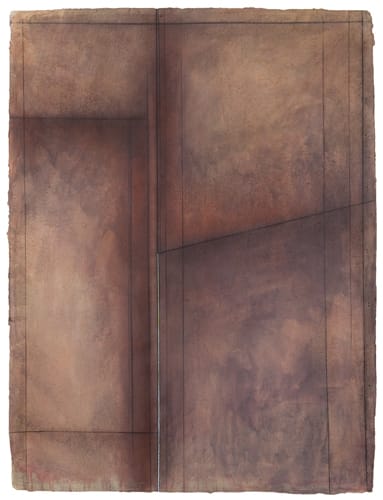Mehlli Gobhai: Epiphanies: A series of breakthrough moments
Curated by Ranjit Hoskote & Nancy Adajania
Meherwan Minocher Gobhai (1931-2018), always known as Mehlli Gobhai, was one of India’s most distinguished and pathbreaking abstractionists. Educated at St Xavier’s College and the Government College of Law, Mumbai, the Royal College of Art, London, the Pratt Graphics Center and the Art Students League, New York, Gobhai lived in New York from the early 1960s to the mid-1980s. Returning to Mumbai, he became a dynamic, enthusiastic contributor to its cultural life, a lively presence in the city’s art and literary worlds. He enriched every conversation with his empathy, nimble curiosity, and kaleidoscopic imagination. In his paintings, Gobhai combined an incisive geometry with a sensuous delight in textures suggestive of flint or burnished leather. His sources of inspiration included patterned river stones, non-iconic wayside shrines, Chola bronzes, and alchemical metaphors. He regarded colour as a temptation best submerged in the palette of sepia, umber, burnt sienna and charcoal grey that he came to favour.
‘Epiphanies’ is an edited extract of ‘Don’t Ask Me About Colour’, the large-scale retrospective that we curated at the National Gallery of Modern Art, Mumbai, in March 2020, bearing witness to nearly 70 years of Mehlli Gobhai’s art. Cut short by the Covid lockdown, the retrospective ranged from the artist’s teenage drawings, made in 1947, to the extraordinary paintings he made in an arc of productivity from 1974 to 2014. We presented, for the first time, the intense, remarkably fresh polychrome paintings that mark Gobhai’s transition from representation to abstraction. Their percussive yellows, blues, greens and reds shocked viewers familiar only with the penumbral tonalities of his later phase. We presented his mixed-media works, rendered in graphite, dry pastel and aluminium powder. Viewers discovered his masterly life studies and his forays into print-making, as well as the children’s books he wrote and illustrated, several of them inspired by Indian folktales.
We also developed a portrait of Gobhai as a participant in culture at large – as connoisseur, designer, and collector. As an advertising professional, he had worked as art director with J. Walter Thompson. His extra-painterly commitments spanned theatre (he trained as an actor with Ebrahim Alkazi), music (an interest inherited from his mother, a devotee of classical Western music; he was a votary of the Hindustani and Carnatic traditions), dance (he savoured Bharatanatyam), and folk culture (he enjoyed collecting textiles, which formed an integral part of the distinctive domestic environments he created in Mumbai, New York, and Gholvad, his rural retreat north of Mumbai).
‘Epiphanies’ focuses on the key moments of breakthrough in Gobhai’s art: his celebration of colour in 1974-1975, his move towards a dark palette in 1976, his experiments with dry pastels and aluminium powder in 1981, his improvisation of the ‘constructed canvas’ in the 1990s and his blurring of the line between painterly surface and sculptural contour. Mehlli Gobhai’s legacy resides as much in the works exhibited here, as in the lives he touched with his warmth, friendship, love and generosity.
-
 Mehlli Gobhai, Untitled, 2010
Mehlli Gobhai, Untitled, 2010 -
 Mehlli Gobhai, Untitled, 2010
Mehlli Gobhai, Untitled, 2010 -
 Mehlli Gobhai, Untitled, 2010
Mehlli Gobhai, Untitled, 2010 -
 Mehlli Gobhai, Untitled, 2010
Mehlli Gobhai, Untitled, 2010 -
 Mehlli Gobhai, Untitled (Colour), c. 1970's
Mehlli Gobhai, Untitled (Colour), c. 1970's -
 Mehlli Gobhai, Untitled (Colour), c. 1970's
Mehlli Gobhai, Untitled (Colour), c. 1970's -
 Mehlli Gobhai, Untitled (Colour), c. 1970's
Mehlli Gobhai, Untitled (Colour), c. 1970's -
 Mehlli Gobhai, Untitled (Colour), April 1975
Mehlli Gobhai, Untitled (Colour), April 1975 -
 Mehlli Gobhai, Untitled (Energy diagram), late 1970's
Mehlli Gobhai, Untitled (Energy diagram), late 1970's -
 Mehlli Gobhai, Untitled (Energy Diagrams), c. 1970's
Mehlli Gobhai, Untitled (Energy Diagrams), c. 1970's -
 Mehlli Gobhai, Untitled (Energy Diagrams), late 1970's
Mehlli Gobhai, Untitled (Energy Diagrams), late 1970's -
 Mehlli Gobhai, Untitled (Energy Diagrams), late 1970's
Mehlli Gobhai, Untitled (Energy Diagrams), late 1970's













